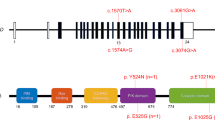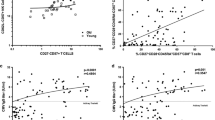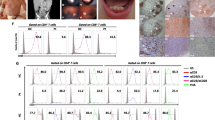Abstract
The Y chromosome (Yaa gene) from autoimmune BXSB mice has been shown to be responsible for the acceleration of autoimmune symptoms when transferred to MRL/lpr mice. We examined the pathological, serological and immunological characteristics of MRL/lpr.Yaa mice and the suppressive effect of cyclophosphamide (CP) on the mice. MRL/lpr.Yaa mice spontaneously developed a massive lymphadenopathy characterized by hypergammaglobulinemia, the presence of several autoantibodies, and autoimmune disease. In MRL/lpr.Yaa mice, IL-2, IL-4 and IL-5 production in concanavalin A (Con A)-stimulated splenocytes were about 10-fold lower than in BALB/c mice at 5 weeks of age.The concentrations of these lymphokines remained low until the mice were 16 weeks of age. The production of IFN-γ and IL-6 in 16 week old MRL/lpr.Yaa mice was about 4- and 2-fold lower, respectively, though these levels were similar in both strains at 8 weeks of age. It was found that this dysregulation of T cell function was almost identical to that in MRL/lpr mice. Administration of CP to MRL/lpr.Yaa mice ameliorated nephritis, and suppressed production of autoantibodies and the accumulation of abnormal T cells. CP also significantly elevated the production of lymphokines. These findings suggest that an abnormality of T cell function may contribute to the autoimmune pathogenesis of MRL/lpr.Yaa mice and that CP probably ameliorates autoimmune disease by improving the T cell functions.
Similar content being viewed by others
References
Andrews BS, Eisenberg RA, Theofilopoulos AN, Izui S, Wilson CB, McConahey PJ,et al. Spontaneous murine lupuslike syndromes: clinical and immunopathological manifestations in several strains. J Exp Med 1978;148:1198–215.
Hang LM, Theofilopoulos AN, Dixon FJ. A spontaneous rheumatoid arthritis-like disease in MRL/l mice. J Exp Med 1982;155:1690–701.
Hang LM, Aguado MT, Dixon FJ, Theofilopoulos AN. Induction of severe autoimmune disease in normal mice by simultaneous action of multiple immunostimulators. J Exp Med 1985;161:423–8.
Morse HC, Davidson WF, Yetter RA, Murphy ED, Roths JB, Coffman RL. Abnormalities induced by the mutant genelpr: expansion of a unique lymphocyte subset. J Immunol 1982;129:2612–5.
Patarca R, Wei F-Y, Singh P, Morasso MI, Cantor H. Dysregulated expression of the T cell cycokineEta-1 in CD4−8− lymphocytes during the development of murine autoimmune disease. J Exp Med 1990;172:1177–83.
Lampe MA, Patarca R, Iregui MV, Cantor H. Polyclonal B cell activation by the Eta-1 cytokine and the development of systemic autoimmune disease. J Immunol 1991;147:2902–6.
Izui S, Masuda K, Yoshida H. Acute SLE in F1 hybrids between SB/Le and NZW mice: prominently enhanced formation of gp70 immune complexes by a Y chromosomeassociated factor from SB/Le mice. J Immunol 1984;132:701–4.
Hudgins CC, Steinberg RT, Klinman DM, Reeves JP, Steinberg AD. Studies of consomic mice bearing the Y chromosome of the BXSB mouse. J Immunol 1985;134:3849–54.
Izui S, Higaki M, Morrow D, Merino R. The Y chromosome from autoimmune BXSB/MpJ mice induces a lupus-like syndrome in (NZWxC57BL/6)F1 male mice, but not in C57BL/6 male mice. Eur J Immunol 1988;18:911–5.
Suzuka H, Yoshifusa H, Nakamura Y, Miyawaki S, Shibata Y. Morphological analysis of autoimmune disease in MRL-lpr.Yaa male mice with rapidly progressive systemic lupus erythematosus. Autoimmunity 1993;14:275–82.
Shiraki M, Fujiwara M, Tomura S. Long term administration of cyclophosphamide in MRL/1 mice: the effects on the development of immunological abnormalities and lupus nephritis. Clin Exp Immunol 1984;55:333–9.
Shiraki M, Fujiwara M. Long term administration of cyclophosphamide into MRL/1 mice: the effects on the isotype of anti-DNA antibodies and immunoglobulin secreting cells in the spleen. Clin Exp Immunol 1984;55:519–24.
Rordorf C, Pataki A, Nogues V, Schlager F, Feige U, Glatt M. Arthritis in MRL/lpr mice and in collagen II sensitized DBA-1 mice and their use in pharmacology. Int J Tissue React 1987;9:341–7.
Miyawaki S, Nakamura Y, Takeshita T, Yoshida H, Shibata Y, Mitsuoka S. Marked acceleration of the autoimmune disease in MRL-lpr/lpr mice by the influence of theYaa gene from BXSB mice. Lab Ani Sci 1988;38:266–72.
Zimmermann M. Ethical guidelines for investigations of experimental pain in conscious animals. Pain 1983;16:109–10.
Eisenberg RA, Izui S, McConahey PJ, Hang L, Peters CJ, Theofilopoulos AN, et al. Male determined accelerated autoimmune disease in BXSB mice: transfer by bone marrow and spleen cells. J Immunol 1980;125:1032–6.
Watanabe-Fukunaga R, Brannan CI, Copeland NG, Jenkins NA, Nagata S. Lymphoproliferation disorder in mice explained by defects in Fas antigen that mediates apoptosis. Nature 1992;356:314–7.
Altman A, Theofilopoulos AN, Weiner R, Katz DH, Dixon FJ. Analysis of T cell function in autoimmune murine strains: defects in production of and responsiveness to interleukin 2. J Exp Med 1981;154:791–808.
Wofsy D, Murphy ED, Roths JB, Dauphinee MJ, Kipper SB, Talal N. Deficient interleukin 2 activity in MRL/Mp and C57BL/6J mice bearing thelpr gene. J Exp Med 1981;154:1671–80.
Dauphinee MJ, Kipper SB, Wofsy D, Talal N. Interleukin 2 deficiency is a common feature of autoimmune mice. J Immunol 1981;127:2483–7.
Santoro TJ, Benjamin WR, Oppenheim JJ, Steinberg AD. The cellular basis for immune interferon production in autoimmune MRL-lpr/lpr mice. J Immunol 1983;131:265–8.
Umland S, Lee R, Howard M, Martens C. Expression of lymphokine genes in splenic lymphocytes of autoimmune mice. Mol Immunol 1989;26:649–56.
Manolios N, Schrieber L, Nelson M, Geczy CL. Enhanced interferon-gamma (IFN) production by lymph node cells from autoimmune(MRL/1, MRL/n) mice. Clin Exp Immunol 1989;76:301–6.
MacNeil D, Krystal G, Fairhurst M, Waterfield JD. Correction of defective IL-3 responses of T lymphocytes from autoimmune mice. J Immunol 1986;137:3464–8.
Katagiri K, Katagiri T, Eisenberg RA, Ting J, Cohen PL. Interleukin 2 responses oflpr and normal L3T4/Lyt-2 T cells induced by TPA plus A23817. J Immunol 1987;138:149–56.
Murray L, Martens C. The abnormal T lymphocytes inlpr mice transcribe interferon-γ and tumour necrosis factor-α genes spontaneouslyin vivo. Eur J Immunol 1989;19:563–5.
Murray LJ, Lee R, Martens C.In vivo cytokine gene expression in T cell subsets of the autoimmune MRL/Mp-lpr/lpr mouse. Eur J Immunol 1990;20:163–70.
Mori K, Kobayashi S, Inobe M, Jia W-Y, Tamakoshi M, Miyazaki T et al. In vivo cytokine gene expression in various T cell subsets of the autoimmune MRL/Mp-lpr/lpr mouse. Autoimmunity 1994;17:49–57.
Santoro TJ, Lehmann KR, Batt RA, Kotzin BL. The role of L3T4+ cells in the pathogenesis of lupus inlpr-bearing mice: defects in the production of interleukins 2 and 3. Eur J Immunol 1987;17:1131–6.
Budd RC, Schumacher JH, Winslow G, Mosmann TR. Elevated production of interferon-γ and interleukin 4 by mature T cells from autoimmune lpr mice correlates with Pgp-1 (CD44) expression. Eur J Immunol 1991;21:1081–4.
Author information
Authors and Affiliations
Rights and permissions
About this article
Cite this article
Kamada, H., Takaoka, Y., Kitagaki, K. et al. Effect of cyclophosphamide on lymphokine production in MRL/lpr.Yaa mice. Inflamm Res 44, 491–498 (1995). https://doi.org/10.1007/BF01837916
Received:
Revised:
Accepted:
Issue Date:
DOI: https://doi.org/10.1007/BF01837916




